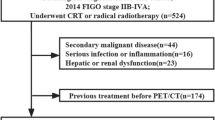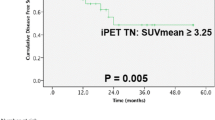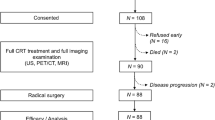Abstract
Background
Chemoradiotherapy (CRT) is used to treat cervical lymph node(s) metastatic head and neck cancer patients. Evaluation and treatment of lymph node(s) after CRT is important to improve the prognosis.
Methods
Prior to CRT, we determined the TNM stage by visual and imaging examinations. Metabolic tumor volume (MTV) and total lesion glycolysis (TLG) were calculated from the results of fluorodeoxyglucose-positron emission tomography (FDG-PET). After CRT, the patients were divided in two groups—complete response (CR) and non-CR—and their responses were compared with the clinical characteristics.
Results
T4, N2b, N2c and TLG2.5 ≥18.8 were statistically significant predictive indices before CRT. The odds ratio, 95 % confidence interval and p value were, respectively—T4: 2.73, 1.15–6.51, 0.0230; N2b: 6.96, 1.50–32.3, 0.0132; N2c: 11.80, 2.37–58.50, 0.00258; and TLG2.5 ≥18.8: 6.25, 2.17–18.00, 0.000672.
Conclusions
TLG was found to be a good predictive factor for metastatic lymph node(s) prior to CRT treatment. After CRT treatment, FDG-PET was found to be highly specific and useful for negative screening.


Similar content being viewed by others
References
Urba SG, Moon J, Giri PG et al (2005) Organ preservation for advanced resectable cancer of the base of tongue and hypopharynx: a Southwest Oncology Group Trial. J Clin Oncol 23:88–95
Fountzilas G, Ciuleanu E, Dafni U et al (2004) Concomitant radiochemotherapy vs. radiotherapy alone in patients with head and neck cancer: a Hellenic Cooperative Oncology Group Phase III Study. Med Oncol 21:95–107
Seiwert TY, Cohen EE (2005) State-of-the-art management of locally advanced head and neck cancer. Br J Cancer 92:1341–1348
Taguchi T, Ikeda Y, Mikami Y et al (2003) Combined radiotherapy and chemotherapy with carboplatin and UFT foe head and neck squamous cell carcinoma. Anticancer Res 23:713–717
Katori H, Tsukuda M, Mochimatsu I et al (2004) Phase I trial of concurrent chemoradiotherapy with docetaxel, cisplatin and 5-fluorouracil (TPF) in patients with locally advanced squamous cell carcinoma of head and neck (SCCHN). Br J Cancer 90:348–352
Fujii M, Tsukuda M, Satake B et al (2004) Phase I/II trial of weekly docetaxel and concomitant radiotherapy for squamous cell carcinoma of the head and neck. Int J Clin Oncol 9:107–112
Taguchi T, Tsukuda M, Mikami Y et al (2006) Concurrent chemoradiotherapy with cisplatin, 5-fluorouracil, methotrexate, and leucovorin in patients with advanced resectable squamous cell carcinoma of the larynx and hypopharynx. Acta Otolaryngol 126:408–413
Katori H, Tsukuda M, Taguchi T (2007) Analysis of efficacy and toxicity of chemotherapy with cisplatin, 5-fluorouracil, methotrexate and leucovorin (PFML) and radiotherapy in the treatment of locally advanced squamous cell carcinoma of the head and neck. Cancer Chemother Pharmacol 59:789–794
Katori H, Tsukuda M, Taguchi T (2007) Concurrent chemoradiotherapy with carboplatin and uracil-tegafur (UFT) for patients with poor performance status with locally advanced squamous cell carcinoma of the head and neck (SCCHN). Acta Otolaryngol 127:1099–1104
Tsukuda M, Ishitoya J, Mikami Y et al (2009) Analysis of feasibility and toxicity of concurrent chemoradiotherapy with S-1 for locally advanced squamous cell carcinoma of the head and neck in elderly cases and/or cases with comorbidity. Cancer Chemother Pharmacol 64:945–952
Tsukuda M, Ishitoya J, Matsuda H et al (2010) Randomized controlled phase II comparison study of concurrent chemoradiotherapy with docetaxel, cisplatin, and 5-fluorouracil versus CCRT with cisplatin, 5-fluorouracil, methotrexate and leucovorin in patients with locally advanced squamous cell carcinoma of the head and neck. Cancer Chemother Pharmacol 66:729–736
Hermann RM, Christiansen H, Rödel RM (2013) Lymph node positive head and neck carcinoma after curative radiochemotherapy: a long lasting debate on elective post-therapeutic neck dissections comes to conclusion. Cancer Radiother 17:323–331
Kanda Y (2013) Investigation of the freely available easy-to-use software ‘EZR’ for medical statistics. Bone Marrow Transplant 48:452–458
Schöder H, Fury M, Lee N et al (2009) PET monitoring of therapy response in head and neck squamous cell carcinoma. J Nucl Med 50:74S–88S
Parsons JT, Mendenhall WM, Stringer SP et al (2002) Squamous cell carcinoma of the oropharynx: surgery, radiation therapy, or both. Cancer 94:2967–2980
Brizel DM, Prosnitz RG, Hunter S et al (2004) Necessity for adjuvant neck dissection in setting of concurrent chemoradiation for advanced head-and-neck cancer. Int J Radiat Oncol Biol Phys 58:1418–1423
Argiris A, Stenson KM, Brockstein BE et al (2004) Neck dissection in the combined-modality therapy of patients with locoregionally advanced head and neck cancer. Head Neck 26:447–455
Lavertu P, Adelsetein DJ, Saxton JP et al (1997) Management of the neck in a randomized trial comparing concurrent chemotherapy and radiotherapy with radiotherapy alone in resectable stage III and IV squamous cell head and neck cancer. Head Neck 19:559–566
Corry J, Peters L, Fisher R et al (2008) N2-N3 neck nodal control without planned neck dissection for clinical/radiologic complete responders—results of Trans Tasman Radiation Oncology Group Study 98.02. Head Neck 30:737–742
Peters LJ, Weber RS, Morrison WH et al (1996) Neck surgery in patients with primary oropharyngeal cancer treated by radiotherapy. Head Neck 18:552–559
Nishimura G, Matsuda H, Tagushi T et al (2012) Treatment evaluation of metastatic lymph nodes after concurrent chemoradiotherapy in patients with head and neck squamous cell carcinoma. Anticancer Res 32:595–600
Yabuki Y, Shiono O, Komatsu M et al (2015) Predictive and prognostic value of metabolic tumor volume (MTV) in patients with laryngeal carcinoma treated by radiotherapy (RT)/concurrent chemoradiotherapy (CCRT). PLoS One 10:e0117924
Picchio M, Kirienko M, Mapelli P et al (2014) Predictive value of pre-therapy 18F-FDG PET/CT for the outcome of 18F-FGD PET-guided radiotherapy in patients with head and neck cancer. Eur J Necl Med Mol Imaging 41:21–31
Schinagl DA, Span PN, Oyen WJ et al (2011) Can FDG PET predict radiation treatment outcome in head and neck cancer? Results of a prospective study. Eur J Nucl Med Mol Imaging 38:1449–1458
Hatt M, Le Pogam A, Visvikis D et al (2012) Impact of partial-volume effect correction on the predictive and prognostic value of baseline 18F-FDG PET images in esophageal cancer. J Nucl Med 53:12–20
Larson SM, Erdi Y, Akhurst T et al (1999) Tumor treatment response based on visual and quantitative changes in global tumor glycolysis using PET-FDG imaging. Clin Positron Imaging 2:159–171
Van de Wiele C, Kruse V, Smeets P et al (2013) Predictive and prognostic value of metabolic tumor volume and total lesion glycolysis in solid tumors. Eur J Nucl Med Mol Imaging 40:290–301
Author information
Authors and Affiliations
Corresponding author
Ethics declarations
Conflict of interest
The authors declare that they have no conflict of interest.
About this article
Cite this article
Nishimura, G., Komatsu, M., Hata, M. et al. Predictive markers, including total lesion glycolysis, for the response of lymph node(s) metastasis from head and neck squamous cell carcinoma treated by chemoradiotherapy. Int J Clin Oncol 21, 224–230 (2016). https://doi.org/10.1007/s10147-015-0890-8
Received:
Accepted:
Published:
Issue Date:
DOI: https://doi.org/10.1007/s10147-015-0890-8




